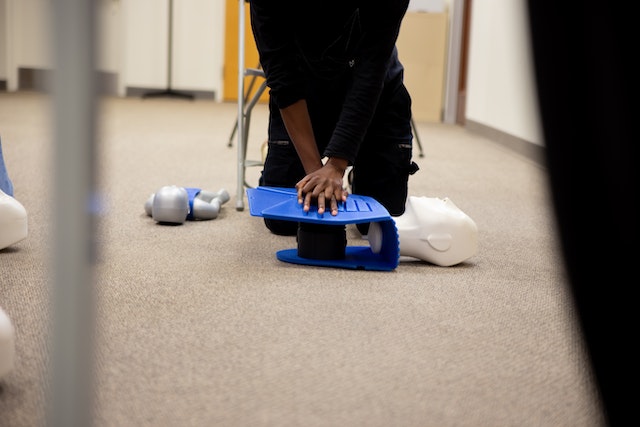
An underexposed risk factor for cardiovascular disease is poor oral health. Relatively few people know what risks this entails. “You can’t say that an unhealthy mouth is life-threatening, but when combined with other factors — high cholesterol, smoking, obesity, and poor dietary habits — it is a risk.” This is what Bruno Loos, professor of periodontology at the Academic Centre for Dentistry Amsterdam (ACTA), and the dentists from Skydental say.
In an oral condition such as periodontitis (gum disease), the gums around the roots and the underlying jawbone of the teeth are inflamed. The severe form occurs in about 10 percent of the population. Periodontitis occurs because so-called pockets form between tooth and gums: the underlying jawbone around the teeth disappears and the teeth and molars can become loose and eventually fall out.
In the inflamed pockets, there are harmful bacteria. The result is that the tissue around the tooth roots loses its protection and bacteria enter the bloodstream more easily, for example, while brushing or eating teeth. If this is the case for a long time, the inflammation around the blood vessels affected by arteriosclerosis worsens. If there is also inflammation in other places in the body, such as with arteriosclerosis and affected coronary arteries, the level of inflammation increases, and the risk of cardiovascular disease increases. In addition, the bacteria in the bloodstream activate platelets (platelets), which cause clots that can lead to myocardial infarction or stroke.
Own teeth
Of people who rarely or never brush, one in ten has a greater risk of cardiovascular disease. Other research shows that the treatment of periodontitis results in an improvement in the condition of the vascular system. The elderly, a large risk group when it comes to heart disease, also benefit greatly from this. Loos calls it commendable that there are ‘mobile dentists’ who hold consultations in care homes or visit vulnerable elderly people at home.
“The longer people keep their teeth, the better. People who still have their teeth usually eat healthier.” Someone with dentures often takes softer food that hardly needs to be chewed. That is regularly fat and sweet, which increases the risk of diabetes and arteriosclerosis. The elderly with gum problems are also entitled to proper treatment, he says. “If there was a wound on the leg or hand, it was treated immediately. Inflamed gums are also an open wound, but you don’t see it.”
Relationship with diabetes
There is not only a relationship between periodontitis and cardiovascular disease but also between periodontitis and diabetes, as has now been established. As a result, the standard of the Dutch General Practitioners Association (NHG) states that a general practitioner inquires about oral health and dental visit when checking a patient with diabetes. “The diabetic patient who has inflammation, for example, rheumatism, Crohn’s disease or periodontitis, has a risk of increased insulin resistance.”
In the case of periodontitis, it appears that its treatment can slightly reduce this insulin resistance. Another relationship is that between periodontitis and lung problems. Especially in the elderly, it often happens that they choke, so that food containing bacteria ends up in the trachea. This can cause pneumonia. “Especially because the elderly often have a larger plaque mass on the teeth and tongue back, which also houses bacteria that are responsible for the development of pneumonia.”
Because of a lowered resistance, the elderly are often more susceptible to this. Keeping its teeth Wolter Brands, chairman of the Royal Dutch Society for the Promotion of Dentistry (KNMT) and a dentist himself, calls it striking that the elderly are among the more loyal visitors to the dentist. Only when all kinds of problems start to play a role, one does not come anymore. There are a few things that exacerbate the problems in frail elderly people, he says. In the past, the elderly often had dentures. Although it is more difficult to eat, it is much easier to maintain than your teeth.
Due to the improvement in care, people are getting older; there are more and more elderly people, and they often still have their teeth until old age. Add to that the social changes. In the past, there was a gradual transition from the retirement home through the nursing home to the nursing home. Now people, together with their environment, have to take care of themselves for longer. For people who have difficulty with everyday matters due to old age, dental care is usually not in the first place. Moreover, all kinds of ailments do not make brushing easy.
“Think of rheumatism or Parkinson’s or dementia. You are then dependent on the help of carers.” It only works if the caregiver takes brushing his teeth as for granted as the daily wash. The fact that the elderly continue to take good care of their teeth is very important, he says. Poor oral health can not only contribute to cardiovascular disease and poorly adjustable blood sugar levels but also faster aging of the brain. Like Loos, he points out the importance of being able to chew well, for example, to prevent malnutrition. Finally, a clean mouth and fresh breath also help to maintain social contacts.
ALSO READ: 8 Diet Tips That Can Benefit Your Cardiovascular System
Good advice
Going to the dentist irregularly or not at all causes problems, in the long run, brands says. Toothache, for example, is one of the worst pains a patient can have, or gum problems. Initially, someone notices little of it. The gums can bleed a bit and sometimes the breath is less fresh, but in the initial phase, people do not suffer much. The partner sometimes notices and sends the other half to a dentist.
The patient often only starts to suffer from it when the problem is already advanced. For example, if the teeth and molars start to stand loose. “It is precisely that insidious nature of gum problems that is difficult.” Not all patients who are warned by the dentist about a gum problem and urged to pay more attention to their teeth follow the good advice.
Because they are not bothered by anything at that moment, they quickly fall into their old behavior, Brands explains. “They clean their teeth well for a few weeks to please the dentist and then forget about it.” Until problems arise, such as a loose tooth or molar. In that case, there is often not much more to do in terms of treatment. Some people think that another implant can be placed, but the bacteria that are in the inflamed tooth tissue around the teeth are also bad for the gums around an implant.
Also, emphasizing the link between oral problems and the risk of cardiovascular disease does not always have the desired effect. Many people don’t change their behavior until they experience the first problems. “Take smoking. There have been campaigns against smoking for years in which all kinds of possible terrible consequences are shown. But there remains a group that thinks that doesn’t happen to them.”
Disposable Teeth
In children, the function of milk teeth is sometimes underestimated, he continues. “There are people who see it as a kind of disposable teeth.” Nothing could be further from the truth. The baby teeth keep the place open for the permanent teeth. If a milk molar has to be pulled because of a toothache, other molars slide up and the successor of the pulled milk germ breaks through in a strange place, for example towards the tongue or to the palate. “It then takes a lot of time at a later age before a brace has the matter back in line.”
Research into dental visits among children between 2 and 18 years of age shows that there are large regional differences. Especially in Zeeuws-Vlaanderen, het Gooi and the cities of Amsterdam, Rotterdam and The Hague, absenteeism is highest. Absenteeism is lowest in parts of Noord-Brabant, Gelderland, Limburg and Drenthe. In the Netherlands there are 500,000 children between the ages of 2 and 4; more than half do not go under control.
From the age of 4, the percentage rises considerably (80 percent). “But then the damage has often already been done,” says Loos. In the best case, it is a small hole that can be stopped with the right brushing and nutrition advice. But dentists also see toddlers who need teeth to be pulled or root canals and crowns are needed. Brands think that the omission has to do with a misconception.
The National Care Survey shows that more than two in five Dutch people do not know that dental visits of children are reimbursed from the basic insurance without a personal contribution or deductible. Another possible explanation: parents do not have dental insurance themselves and then do not go to the dentist with their child. Worrying, brands think. “Healthy teeth give you a lifetime of pleasure. Taking good care of your teeth yourself and every year at a check-up to the dentist is the basis for this. Every child has the right to that.”
Self-awareness
Nevertheless, much has been improved. Until the sixties of the last century, the oral health of the Dutch population was in a bad state. There was hardly any attention to the prevention of tooth decay and the treatment options were limited. Many people had their (affected) teeth extracted at a relatively young age; the dentures were seen as a great alternative.
In the second half of the sixties, this changed. Government, health institutions, and dentists took initiatives to stimulate dental awareness. Long-term public campaigns made the population aware of the need for dental care. Fluoridation of toothpaste and fluoride applications in youth were effective against caries. At the same time, the preventive dental visit was stimulated.
With periodic check-ups, many dental problems can be detected in time and major damage can be prevented. The rapid development of dental techniques and materials also contributed to the fact that tooth extraction can increasingly be prevented or postponed. The experience and expectations of patients about the functionality and especially the aesthetics of the teeth went along with this. “Beautiful teeth contribute to well-being and self-awareness,” says Brands.
 Getting a regular massage (마사지 ) in South Korea is very much a part of South Korean culture and lifestyle, being a relaxation technique that brings many health benefits
Getting a regular massage (마사지 ) in South Korea is very much a part of South Korean culture and lifestyle, being a relaxation technique that brings many health benefits When in South Korea, be in the know that massage clinics are widely available throughout the country. Spas and beauty shops also offer massage services in different styles and techniques. However, due to language barriers, some tourists got more than what they bargained for; not realizing that they ordered an extreme type of massage service.
When in South Korea, be in the know that massage clinics are widely available throughout the country. Spas and beauty shops also offer massage services in different styles and techniques. However, due to language barriers, some tourists got more than what they bargained for; not realizing that they ordered an extreme type of massage service.















 Apparently, slow metabolism can be a natural condition for some people, particularly the older overweight and obese individuals who are no longer interested in staying active. Alpilean can provide the solution since its formulation is designed to increase body temperature to boost slow metabolism, which in turn spurs the body to burn calories at a faster rate.
Apparently, slow metabolism can be a natural condition for some people, particularly the older overweight and obese individuals who are no longer interested in staying active. Alpilean can provide the solution since its formulation is designed to increase body temperature to boost slow metabolism, which in turn spurs the body to burn calories at a faster rate.










 During the last decades, medical cases of Indians experiencing premature heart attacks caused by coronary artery disease (CAD) confirmed observations that Indians have higher CAD mortality and morbidity risks than their foreign counterparts.
During the last decades, medical cases of Indians experiencing premature heart attacks caused by coronary artery disease (CAD) confirmed observations that Indians have higher CAD mortality and morbidity risks than their foreign counterparts.
 At the Rana Hospital, Senior Interventional Cardiologist and Director, Dr Senthilkumar Nallusamy added that consumption of trans fats and alcohol, as well as smoking and mental stress, are additional factors that increase the risks of coronary artery disease in young patients.
At the Rana Hospital, Senior Interventional Cardiologist and Director, Dr Senthilkumar Nallusamy added that consumption of trans fats and alcohol, as well as smoking and mental stress, are additional factors that increase the risks of coronary artery disease in young patients. According to Kauvery Hospitals Tiruchy’s Chief Interventional Consultant and Cardiologist, Dr S Aravindakumar, about 15 to 20 per cent of below age 40 patients who suffer from a heart disorder also suffer from mental stress. Many of them are young corporate employees, working as ITs dealing with US clients.
According to Kauvery Hospitals Tiruchy’s Chief Interventional Consultant and Cardiologist, Dr S Aravindakumar, about 15 to 20 per cent of below age 40 patients who suffer from a heart disorder also suffer from mental stress. Many of them are young corporate employees, working as ITs dealing with US clients.

